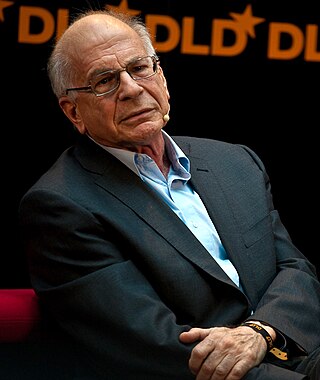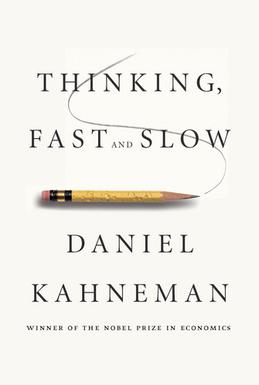Related Research Articles

A cognitive bias is a systematic pattern of deviation from norm or rationality in judgment. Individuals create their own "subjective reality" from their perception of the input. An individual's construction of reality, not the objective input, may dictate their behavior in the world. Thus, cognitive biases may sometimes lead to perceptual distortion, inaccurate judgment, illogical interpretation, or what is broadly called irrationality.
A heuristic, or heuristic technique, is any approach to problem solving or self-discovery that employs a practical method that is not guaranteed to be optimal, perfect, or rational, but is nevertheless sufficient for reaching an immediate, short-term goal or approximation. Where finding an optimal solution is impossible or impractical, heuristic methods can be used to speed up the process of finding a satisfactory solution. Heuristics can be mental shortcuts that ease the cognitive load of making a decision.

Amos Nathan Tversky was an Israeli cognitive and mathematical psychologist and a key figure in the discovery of systematic human cognitive bias and handling of risk.

Behavioral economics studies the effects of psychological, cognitive, emotional, cultural and social factors on the decisions of individuals or institutions, such as how those decisions vary from those implied by classical economic theory.
The availability heuristic, also known as availability bias, is a mental shortcut that relies on immediate examples that come to a given person's mind when evaluating a specific topic, concept, method, or decision. This heuristic, operating on the notion that, if something can be recalled, it must be important, or at least more important than alternative solutions not as readily recalled, is inherently biased toward recently acquired information.
Hindsight bias, also known as the knew-it-all-along phenomenon or creeping determinism, is the common tendency for people to perceive past events as having been more predictable than they actually were. People often believe that after an event has occurred, they would have predicted or perhaps even would have known with a high degree of certainty what the outcome of the event would have been before the event occurred. Hindsight bias may cause distortions of memories of what was known or believed before an event occurred, and is a significant source of overconfidence regarding an individual's ability to predict the outcomes of future events. Examples of hindsight bias can be seen in the writings of historians describing outcomes of battles, physicians recalling clinical trials, and in judicial systems as individuals attribute responsibility on the basis of the supposed predictability of accidents.
The representativeness heuristic is used when making judgments about the probability of an event under uncertainty. It is one of a group of heuristics proposed by psychologists Amos Tversky and Daniel Kahneman in the early 1970s as "the degree to which [an event] (i) is similar in essential characteristics to its parent population, and (ii) reflects the salient features of the process by which it is generated". Heuristics are described as "judgmental shortcuts that generally get us where we need to go – and quickly – but at the cost of occasionally sending us off course." Heuristics are useful because they use effort-reduction and simplification in decision-making.

Trait ascription bias is the tendency for people to view themselves as relatively variable in terms of personality, behavior and mood while viewing others as much more predictable in their personal traits across different situations. More specifically, it is a tendency to describe one's own behaviour in terms of situational factors while preferring to describe another's behaviour by ascribing fixed dispositions to their personality. This may occur because peoples' own internal states are more readily observable and available to them than those of others.
The conjunction fallacy is an inference from an array of particulars, in violation of the laws of probability, that a conjoint set of two or more conclusions is likelier than any single member of that same set. It is a type of formal fallacy.
The anchoring effect is a cognitive bias whereby an individual's decisions are influenced by a particular reference point or 'anchor'. Both numeric and non-numeric anchoring have been reported in research. In numeric anchoring, once the value of the anchor is set, subsequent arguments, estimates, etc. made by an individual may change from what they would have otherwise been without the anchor. For example, an individual may be more likely to purchase a car if it is placed alongside a more expensive model. Prices discussed in negotiations that are lower than the anchor may seem reasonable, perhaps even cheap to the buyer, even if said prices are still relatively higher than the actual market value of the car. Another example may be when estimating the orbit of Mars, one might start with the Earth's orbit and then adjust upward until they reach a value that seems reasonable.

The simulation heuristic is a psychological heuristic, or simplified mental strategy, according to which people determine the likelihood of an event based on how easy it is to picture the event mentally. Partially as a result, people experience more regret over outcomes that are easier to imagine, such as "near misses". The simulation heuristic was first theorized by psychologists Daniel Kahneman and Amos Tversky as a specialized adaptation of the availability heuristic to explain counterfactual thinking and regret. However, it is not the same as the availability heuristic. Specifically the simulation heuristic is defined as "how perceivers tend to substitute normal antecedent events for exceptional ones in psychologically 'undoing' this specific outcome."
In psychology, the human mind is considered to be a cognitive miser due to the tendency of humans to think and solve problems in simpler and less effortful ways rather than in more sophisticated and effortful ways, regardless of intelligence. Just as a miser seeks to avoid spending money, the human mind often seeks to avoid spending cognitive effort. The cognitive miser theory is an umbrella theory of cognition that brings together previous research on heuristics and attributional biases to explain when and why people are cognitive misers.
Attribute substitution, also known as substitution bias, is a psychological process thought to underlie a number of cognitive biases and perceptual illusions. It occurs when an individual has to make a judgment that is computationally complex, and instead substitutes a more easily calculated heuristic attribute. This substitution is thought of as taking place in the automatic intuitive judgment system, rather than the more self-aware reflective system. Hence, when someone tries to answer a difficult question, they may actually answer a related but different question, without realizing that a substitution has taken place. This explains why individuals can be unaware of their own biases, and why biases persist even when the subject is made aware of them. It also explains why human judgments often fail to show regression toward the mean.
Fuzzy-trace theory (FTT) is a theory of cognition originally proposed by Valerie F. Reyna and Charles Brainerd that draws upon dual-trace conceptions to predict and explain cognitive phenomena, particularly in memory and reasoning. The theory has been used in areas such as cognitive psychology, human development, and social psychology to explain, for instance, false memory and its development, probability judgments, medical decision making, risk perception and estimation, and biases and fallacies in decision making.
Heuristics is the process by which humans use mental short cuts to arrive at decisions. Heuristics are simple strategies that humans, animals, organizations, and even machines use to quickly form judgments, make decisions, and find solutions to complex problems. Often this involves focusing on the most relevant aspects of a problem or situation to formulate a solution. While heuristic processes are used to find the answers and solutions that are most likely to work or be correct, they are not always right or the most accurate. Judgments and decisions based on heuristics are simply good enough to satisfy a pressing need in situations of uncertainty, where information is incomplete. In that sense they can differ from answers given by logic and probability.

Thinking, Fast and Slow is a 2011 book by psychologist Daniel Kahneman.
Illusion of validity is a cognitive bias in which a person overestimates their ability to interpret and predict accurately the outcome when analyzing a set of data, in particular when the data analyzed show a very consistent pattern—that is, when the data "tell" a coherent story.
Cognitive bias mitigation is the prevention and reduction of the negative effects of cognitive biases – unconscious, automatic influences on human judgment and decision making that reliably produce reasoning errors.
Social heuristics are simple decision making strategies that guide people's behavior and decisions in the social environment when time, information, or cognitive resources are scarce. Social environments tend to be characterised by complexity and uncertainty, and in order to simplify the decision making process, people may use heuristics, which are decision making strategies that involve ignoring some information or relying on simple rules of thumb.
References
- 1 2 Ashcraft, M.H. (2006). Cognition. Upper Saddle River, New Jersey; Pearson Education Inc. ISBN 013198229X
- ↑ Bernstein, D. M.; Erdfelder, E; Meltzoff, A. N.; Peria, W; Loftus, G. R. (2011). "Hindsight bias from 3 to 95 years of age". Journal of Experimental Psychology. 37 (2): 378–391. doi:10.1037/a0021971. PMC 3084020 . PMID 21299327.
- ↑ Goel, V; Makale, M; Grafman, J (2004). "The Hippocampal System Mediates Logical Reasoning about Familiar Spatial Environments". Journal of Cognitive Neuroscience. 16 (4): 654–664. doi:10.1162/089892904323057362. PMID 15165354. S2CID 2020044.
- 1 2 Corneille, O.; Monin, B.; Pleyers, G. (2004). "Is positivity a cue or a response option? Warm glow vs evaluative matching in the familiarity for attractive and not-so-attractive faces". Journal of Experimental Social Psychology. 41 (4): 431–437. doi:10.1016/j.jesp.2004.08.004.
- ↑ Monin, Benoît (2003). "The Warm Glow Heuristic: When Liking Leads to Familiarity". Journal of Personality and Social Psychology. 85 (6): 1035–48. doi:10.1037/0022-3514.85.6.1035. PMID 14674812.
- ↑ Park, C. Whan; Lessig, V. Parker (1981). "Familiarity and its impact on consumer decision biases and heuristics". Journal of Consumer Research. 8 (2): 223–230. doi:10.1086/208859. hdl: 1808/10100 .
- ↑ Cytryn, K.N. (2001). Lay reasoning and decision-making related to health and illness. PhD Thesis, McGill University, Canada.
- ↑ Albarracín, D; Wyer Jr, R. S. (2000). "The cognitive impact of past behavior: influences on beliefs, attitudes, and future behavioral decisions". Journal of Personality and Social Psychology. 79 (1): 5–22. doi:10.1037/0022-3514.79.1.5. PMC 4807731 . PMID 10909874.
- ↑ Ouellette, Judith A.; Wood, Wendy (1998). "Habit and intention in everyday life: the multiple processes by which past behavior predicts future behavior". Psychological Bulletin. 124: 54–74. doi:10.1037/0033-2909.124.1.54.